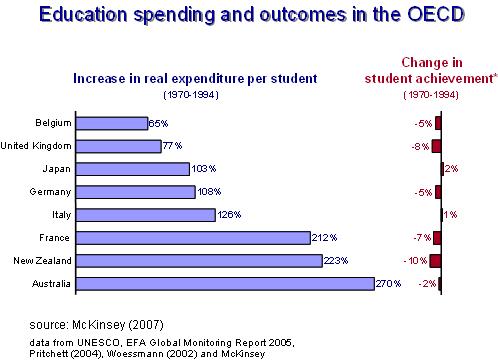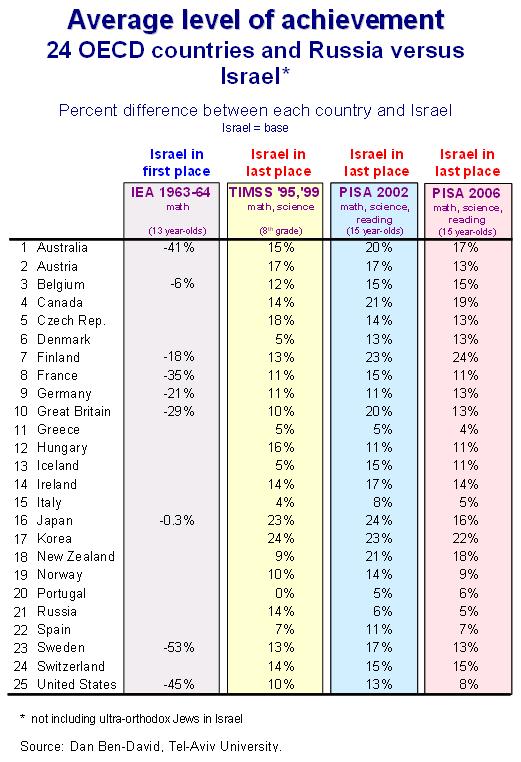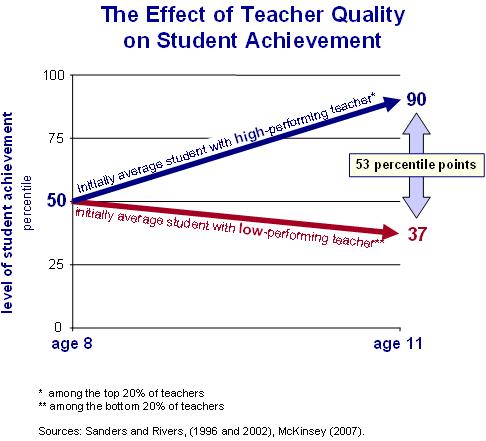|
This is no longer the case, nor has it
been the case for quite a while now. Since
the 1990’s American pupils have scored roughly 10% above Israeli pupils. Depending on the test, achievement levels of
French and German children have been 11%-15% higher, British scores have been 10%-20%
higher, and Australian scores have been 15%-20% higher. In fact, the children in every single one of
the 24 OECD countries and Russia (as well as in many additional countries) have
outperformed Israel’s children.
Not only were achievement levels
higher in each of the other 24 countries, education gaps within each of those
countries were substantially lower than Israel’s as well. In most countries, educational inequality was
lower by a substantial double-digit percentage (see table). In the most recent PISA test, for 2006, published
a few weeks ago, Israel achieved the dubious distinction of being the country
with the most unequal education among every one of the 57 participating
countries.

It is important to emphasize that the
Israelis tested did not include ultra-orthodox pupils, so the actual national
level is even lower than that shown here, while actual educational disparity
within the country is higher. Israel’s
education system has failed completely in comparison with each of the 24
countries.
The Black
Hole
The education system is a black hole
that swallows more than the children of Israel’s future. It also swallows enormous budgets. The government as a whole, and the Ministries
of Education and Finance in particular, have not learned anything from our own
experience in the nineties. Israel’s
education budget ballooned relative to other developed countries while test
scores continued their unabated fall. Nothing
was learned from the experience of other countries as well.
When Israel is compared with these
same countries in terms of expenditure per pupil – after correcting for
differences in living standards across countries, as was done for teachers’
salaries above – it turns out that the problem in Israel is not a lack of money
spent on education but a lack of sense regarding how that money is being spent. Israel spent more than two-thirds of the OECD
countries in 2004 (the most recent year for which there is comparable
expenditure information). On average, Israel
spent 4% more per pupil than these 24 countries while providing a substantially
worse education than each on of them. In
short, while sufficient funds are important, they guarantee nothing when
propelled into a dysfunctional system.
There are countries that spend a lot
and achieve little and there are countries that spend little but are
nonetheless able to attain a considerable amount. During two and a half decades, from 1970 to 1994,
Belgium increased its expenditure per pupil by 65% (see diagram). During this period, there was no comparable
improvement in student achievements. As
a matter of fact, there was no improvement at all. Instead of rising, Belgium’s scores fell by 5%. England increased expenditures per pupil by 77%
while its achievement levels fell by 8%.
Japan and Germany doubled their expenditures per student, France tripled
its expenditures, and Australia nearly quadrupled its expenditures, but student
achievements exhibited negligible change at best, and actual drops at worst

Real
Reform
Airy-fairy conventional wisdom so
popular in the public debate is not a substitute for facts-based appraisal and
policy formulation. The former yields
delusional reform and superficial solutions while the latter requires an
unbiased examination of the true underlying reasons for what has gone so
catastrophically wrong in Israel’s education system. Also required: a courageous leadership
willing to face the facts and face the electorate.
Among the necessary first steps in any
real reform is the creation of a culture of complete transparency with regard
to all expenditures, achievements and administration. No thorough understanding of the facts can be
forthcoming while an intentionally thick – and politically expedient – veil
continues to obscure the functioning of the education system.
For example, a debate rages today
about returning instruction hours to a system that is already funding more
instruction hours at the ages of 7 to 14 than 22 of 26 OECD countries. The reason that Israeli schools are unable to
provide sufficient instruction time, despite this, is due to myriad alternative
avenues that exist for redirecting funds specifically designated for teaching
hours.
When the number of pupils per teacher
in Israel exactly equals the OECD average, it is annoying – to say the least –
that classes in the national education system (as opposed to the ultra-orthodox
system, for example) are 50% larger than those in the OECD. Transparency can reveal the extent of
discrimination and misappropriation. But
leadership is essential for eradicating these problematic habits and
establishing identical standards in each of the educational systems in every
part of the country.
While a real reform would increase the
education budget during the transition period, it would lead to improvements
that would allow future budgets to align with western standards. A real reform must be based on three key
ingredients: (1) the quality of teachers, (2) the quality of curriculums, and (3)
the quality of management and organization at all levels. An improvement in just one ingredient without
the other two will lead to a large waste in resources.
Talented teachers who are carefully
chosen and properly compensated must be able to work with substantially upgraded
curriculums that are much more focused on core subjects (reading, writing, arithmetic,
science, English, and so on). Even then,
this is not enough. The education system
must make the connection between personal accountability and personal authority
and it needs to utilize positive and negative incentives, as needed, to get
people engaged in educating to give it their best. Unfortunately, a real reform of this type is
not on the radars of anyone currently involved in education policy or strike
negotiations in this country.
The dams built along the Tennessee
river are still standing strong. Too bad
the same can’t be said for the education system built by Israel’s founders two
decades later.
|



